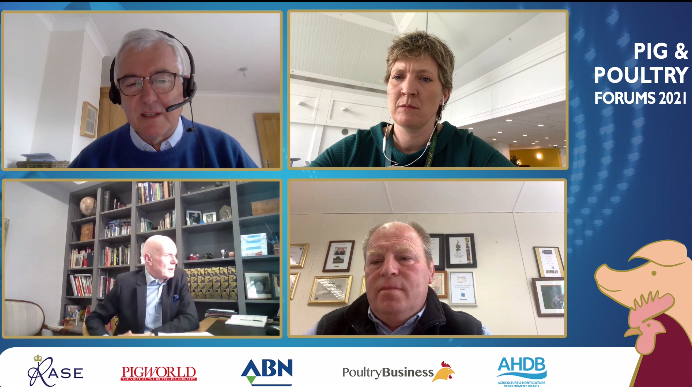The informative Pig & Poultry Forums, which took place yesterday are now available online.
If you missed them the forums can be viewed HERE.
There were three pig forums starting with the Pig Outlook, during which Pilgrim UK’s agriculture director Andrew Saunders explained why pig prices needed to increase on a global scale.
Rising commodity prices, particularly of cereals and other feed ingredients, as well as straw, have left many producers struggling to make ends meet around the world, including in the UK.
He suggested that, broadly, the pig price in kilo terms needs to match the wheat price, per tonne. Currently, it is a very long way short, despite recent UK pig price increases.
New NPA chairman Rob Mutimer set out what he believes are the pork sector’s main challenges ahead, including maintaining its reputation in the eyes of the public and the political drivers affecting the sector, including a possible ban on farrowing crates, the new farming rules for water and moves to address climate change and the industry’s reliance on soya.
Opportunities include the ability to grow our export market and the versatility of pork and the ability to add value to it, he added.
Balancing consumer demands for higher animal welfare with lower emissions, and greater productivity with reduced inputs were common themes through the pig and poultry sessions.
“This is the most seismic time of change for British farming in generations,” said Sophie Throup, head of agriculture, fisheries and sustainable sourcing at Morrisons. Consumer demands are changing, so it’s all about finding the right balance and giving consumers a choice, she said.
During a session on optimising sow and pre-weaning piglet performance, the panel discussed how making small tweaks to management can make a big difference to performance. “Over the past 10 years litter size has increased by 0.3 piglets,” said Dr Steven Jagger, pig nutritionist at ABN. As a result, birth weights have decreased and early mortality has risen.
But through more targeted gilt and sow nutrition, producers can have a massive impact on piglet survival and subsequent fertility, explained Chris Opschoor, feed group manager at Topigs Norsvin. “If a gilt loses more than 12% of her bodyweight during lactation she will have 2.2 fewer piglets born alive in the next litter. This is low hanging fruit – if we’re able to manage this it will have a big positive impact.”
In a session outlining why ammonia is an increasingly important topic and what producers can do to reduce emissions, some ground-breaking innovations were discussed.
This includes treated straw bedding, which reduces emissions and improves animal welfare. By applying Xaletto, a stonemeal additive, to the straw it evaporates 100% of water and urine, leaving a solid, nutrient rich manure for use on farmland or in biogas plants.
According to Daniel Holling at Big Dutchman, provided the house has the right ventilation and pigs are fed a good quality ration, pigs will produce just 25kg of dung in their lifetime compared to 103kg on a slatted system. “And it produces 20% less ammonia than indoor deep straw systems.”
Public perception was another common theme across the sectors, with greater transparency – backed up by data – likely to help in this area. But getting consumers to pay for the higher welfare, carbon neutral systems that they demand is a challenge.
“Integrity has never been more important, and scrutiny has never been greater,” said Tom Willings, chief operating officer at egg produce Stonegate.
Generation Z is all about transparency and environmental credentials – so with the spotlight firmly on Net Zero aspirations, conversations soon turned to both the pig and poultry sectors’ greatest contributor to emissions: Feed.
“Whatever protein source we use will end up more expensive than soya,” said Martin Humphrey at Humphrey Feeds. “But the environmental cost is another matter.”
Insect protein, sunflowers, worms, algae and lupins all offer possible alternatives, but the most sensible and sustainable option is meat and bonemeal, as it provides so much of the protein and nutrients required, and is just a waste product. “If we could use 7.3% meat and bonemeal in poultry rations we could reduce soya to 8% of the diet – that would be a lot more sustainable,” he said.
Around 900 people viewed the sessions live.
Event organiser Alice Bell said: “Keeping abreast of changing market conditions, new technology, and the latest advice will be essential.
“I hope that by bringing the industry together we’ve shared ideas and helped farmers to build their businesses for the future, and look forward to welcoming everyone back to the physical Pig & Poultry Fair in May 2022.”
- Pictured: The Pig Outlook forum – clockwise: AHDB’s Mike Sheldon, who chaired the session, Sophie Throup, Rob Mutimer, Andrew Saunders.




